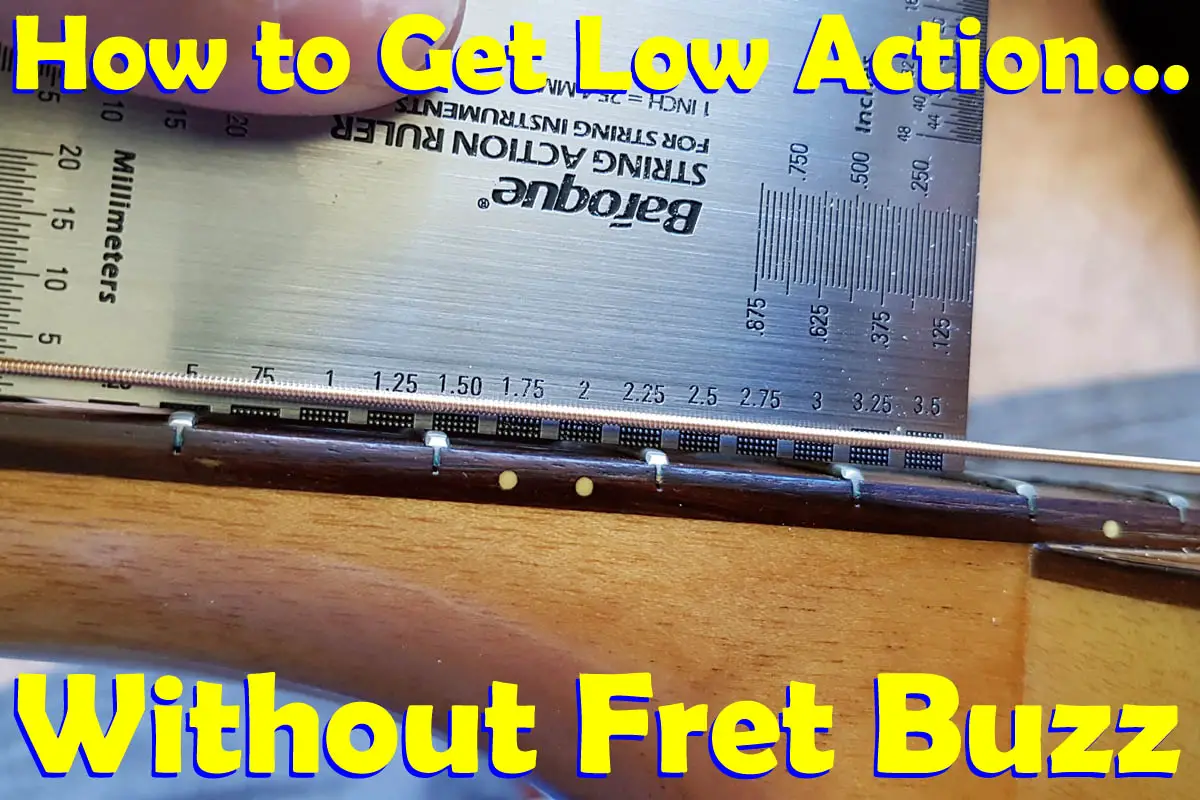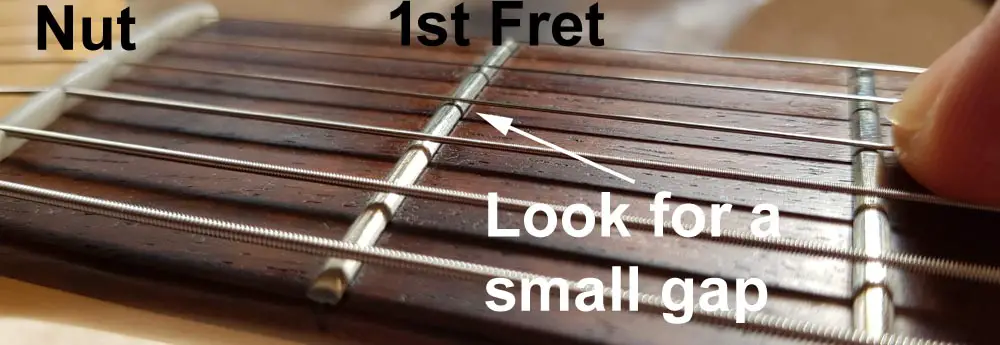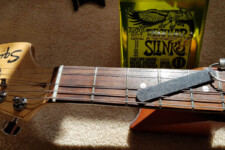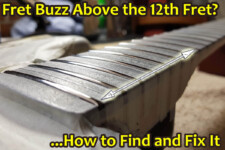How to Get Low Action Without Fret Buzz (In 5 Steps)
Most guitars can be set up to have quite low action, while a few can be set extremely low without nasty fret buzz.
The good news is that even if you have a relatively cheap guitar you can get the action low and fast as long as there is no neck warp.
There are a few things you need to get right before you can get your action this low, and for many players the action can be medium-low and still make your guitar feel much better to play.
With a little knowledge, and sometimes the help of a guitar tech you can get your action nice and low without undue fret buzz.

How Low Can the Action be on a Guitar?
Many used electric guitars have had the action lowered by someone who didn’t fully understand what they were doing, and as a result get too much fret buzz and have poor sustain.
Acoustic guitars often come with a high action direct from the factory as a way to sell guitars that don’t have fret buzz, but this means often the guitars are hard to play.
Nearly all guitars can have the action set much lower without fret buzz if you know what to do.
One thing to keep in mind is that the harder you strum or pick your strings, the more they vibrate. If you are a heavy-handed player, then you are best to keep the action a little higher to prevent too much fret buzz.
- Most electric guitars can often have the action set to under 0.08” (2mm) on the low E string at the 12th fret, with the high E string around 0.06” (1.5mm).
- A good quality electric guitar can be around 0.06” (1.5mm) on the low E string, and 0.045” (1.2mm) for the high E string at the 12th fret.
- Acoustic guitars can have a low E string action of around 0.09” (2.3mm), and high E string around 0.07” (1.8mm) at the 12th fret.
A small amount of fret buzz can be quite normal on a low action electric, but it won’t be enough to dampen your sound or hear the buzz through your amp.
Acoustic guitars have heavier strings which need a little more room to vibrate, and fret buzz is not desirable on them. For a nice clean sound combined with your play style, it’s best to not go too low to begin with.
Five Steps to Get Low Action Without Fret Buzz
There are some basic steps to follow when you want to lower the action, and it’s best to do them in the order listed below. This will help prevent fret buzz while getting the lowest action possible.
Some of these steps are easy for most people to do themselves, while some require more experience, or some work by a guitar tech.
If you are doing this yourself, then you will need to get a few tools such as a fret rocker, hex keys, feeler gauges, and string curvature gauge.
For more advanced setup work you will need tools like nut slot files, a fret crowning file, a flat sanding bar. You will also need a fine file, emery paper, and possibly fret dressing rubbers to get nice polished frets.
1. Check the Neck Relief
The first step is to check the amount of bow (or curve) in your neck, and you only need a slight bow to allow the strings to vibrate in a wider path at the center. If your neck is too flat or bows up in the center you will find that lowering the action will cause excessive fret buzz.
- For the most accurate setting, set your guitar in the playing position, place a capo on the first fret, and then hold the low E string down at one of the highest frets.
- You want to see a gap of about 1/64 inch (0.2mm) between the string and the 7th-8th fret.
- If the gap is too small you need to loosen the truss rod slightly to let the strings bow the neck upward. If the gap is too large, you need to tighten the truss rod to pull the neck down flatter.
2. Check the Fret Level
Now that your neck is correctly set, it’s time to look at the frets to see if any frets are higher than others.
If you want super low action, then this step is absolutely vital. If you have any high spots then you will soon hear fret buzz in different places on the neck while playing, and string bends can cause buzzing severe enough to mute strings.
For a medium action like many acoustic guitarists prefer, this won’t be as much of an issue, but can still give you buzzing on any frets that are much higher than their neighbor frets.
- You will need a fret rocker, or basically any accurate straight edge metal that can fit along the top of 3 frets.
- The idea is to work your way up and down the fretboard between all strings and see if the rocker can rock sideways across any 3 frets.
- If you find any high places on frets your rocker will be able to move a little and for a low action you will either need to get those high spots dressed down, or get a luthier to level the fretboard.
There is a bit more to fret leveling than this, but this is a good way to start and see if you have any obvious problems.
A good fret setup usually involves creating a slight ramp from the 12th-14th fret up to the highest frets, and this can allow really low action without fret buzz.
3.Adjust the Bridge String Height
Once your frets are good enough, it’s time to lower the string height at the bridge.
There are a few bridge designs on electric guitars, so you will need to look up info on your particular bridge if you are not sure how to lower the height of each string.
For Electric Guitars:
- With your guitar in the playing position set the low and high E strings to your desired height.
- Then use a string radius gauge to set the other string heights so they follow the curvature of the fingerboard and frets.
- Play the guitar, and if you are getting too much fret buzz try raising the action slightly until the sound is good.
For Acoustic Guitars:
- First measure the current action and work out how much you need to lower the action.
- Then loosen the strings enough to pull the saddle out of the bridge.
- Mark the saddle and file (or sand) the bottom of the saddle to the mark. Be very careful not to go too low, or you will need to replace the saddle.
- Refit the saddle and tune the guitar back to pitch, and then test by playing.
4.Check the Action at the Nut
Now you are ready to check how high your strings are up at the first fret.
If the action is too low at the nut you will hear fret buzz when playing open strings, and if it’s too high then your guitar can sound out of tune when fretting notes and chords in the first three frets.

For a guitar with only one or two buzzing strings you could fix these problems by filling the nut slot (super glue and baking powder work well) and re-filing the slot. Note that filing a nut slot correctly takes practice and if you’re not sure what you are doing you could end up with a worse sound than you started with.
- Hold each string down separately at the third fret, and check the gap between the string and first fret with a feeler gauge. A gap of 0.012″ (0.3mm) would be about the minimum gap, any lower and you are likely to get fret buzz on open strings.
- If the string touches the fret you will get fret buzz, and the height needs to be increased.
- If the gap is more than about 0.016” (0.4mm) then the string height needs to be lowered a little by filing the nut slots deeper.
To raise the action of strings at the nut you can fill the nut slots and file them again to the correct depth. Often the best course of action is to replace the nut.
5.Play and Adjust to Your Style
Now that you have set your action nice and low, it’s time to actually pick up your guitar and play it, and see if any further adjustment is needed to suit your play style.
If you find there is too much buzzing, then sometimes just a small increase in action can clean up the sound.
On an electric guitar this is easy to do, but on an acoustic you may have to install a new saddle if you have really gone too low.
Another way you can raise the action back a small amount is to loosen the truss rod slightly, being careful not to make the relief too great at the 7th-8th frets.
A Final Word
This is not intended to be an exhaustive guide to doing all this work yourself, but will give you a good overview of how to get low action on your guitar without fret buzz.
If you have a cheaper guitar and don’t mind making some mistakes then you can learn how to do this yourself at home.
For many guitarists, the best option is to visit a guitar store and talk to a professional about how low the action should be on your guitar to suit the way you play.
You may have heard of the Pleck process, and this machine along with an experienced luthier can set your guitar action low with results that will make your guitar feel better than ever to play.




